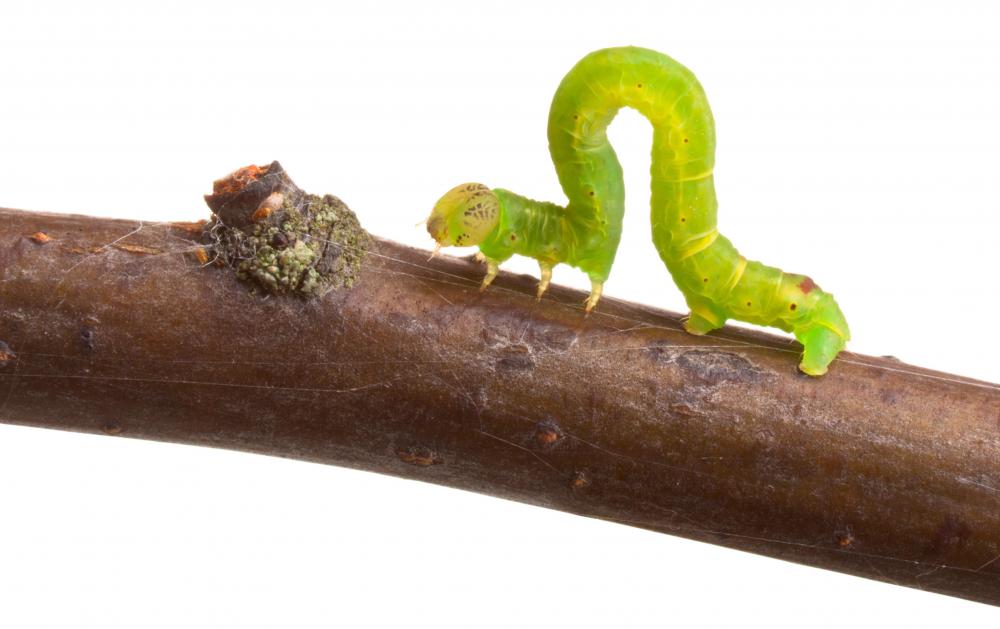At WiseGEEK, we're committed to delivering accurate, trustworthy information. Our expert-authored content is rigorously fact-checked and sourced from credible authorities. Discover how we uphold the highest standards in providing you with reliable knowledge.
What is Bacillus Thuringiensis?
Bacillus thuringiensis (Bt) is a soil-dwelling bacterium that is also naturally occurring on the surface of some plants, and in the gut of some caterpillars. It is commonly used as a pesticide in gardens. Bacillus thuringiensis has little to no effect on humans, wildlife, and beneficial insects and is therefore considered environmentally friendly.
In 1901, Japanese biologist Shigetane Ishiwata first discovered Bacillus thuringiensis, which he called Bacillus sotto. The bacterium was discovered again in 1911 by German biologist Ernst Berliner, who gave it its current name after the German town of Thuringia. the bacterium is closely related to Bacillus cereus, another soil-dwelling bacterium, and Bacillus anthracis, which causes the disease anthrax.

Bacillus thuringiensis has been used as a pesticide since the late 1920s, but did not become widely used until the 1960s, probably due to the problems with dichlorodiphenyltrichloroethane (DDT), a widely used pesticide in the early 20th century. DDT is very poisonous to aquatic animals, birds, and mammals, including humans. It has been linked to asthma, cancer, diabetes, neurological problems, and reproductive problems in humans and does not biodegrade easily.

Bacillus thuringiensis appears to be safe to humans and wildlife. It is usually sprayed on crops, but since the 1980s some plants, including varieties of tobacco, corn, and cotton, have been genetically engineered to express B. thuringiensis toxins, allowing for a reduction in the use of pesticides. This genetic modification prevents insects that are not predators of the crops from being harmed, and delivers a high dosage of the toxin to any pest eating the plant. Some problems arising from the use of B. thuringiensis include the evolution of pests resistant to the toxin and the susceptibility of Bacillus thuringiensis crops to secondary pests not targeted by the toxin.

There are other possible issues related to the use of Bacillus thuringiensis in crops, though they are controversial. Some researchers have claimed that B. thuringiensis maize crops are potentially fatal to the monarch butterfly. Another controversial claim against B. thuringiensis-modified maize is that it is contaminating the natural maize population.

Most recently, some researchers have suggested a possible link between Bacillus thuringiensis and colony collapse disorder (CCD), a phenomenon in which worker bees suddenly disappear from their colony. CCD is a serious agricultural issue worldwide because bees are pollinators for many important crops. None of the concerns raised against B. thuringiensis use have been substantiated, but they have not been positively disproven either, and research about the long term effects of the toxin are ongoing.
AS FEATURED ON:
AS FEATURED ON:














Discussion Comments
@indemnifyme - I wouldn't get too gung-ho about the genetic engineering if I were. I think this issue needs a lot more careful study.
Also, the allegations against bacillus thuringiensis are pretty serious. If it really is making bees abandon their colonies, people should probably stop using it. As the article said, bees are necessary to pollinate crops! Without bees, crops don't grow.
This article was really fascinating. I don't know much about pesticides beyond the fact that DDT is bad and scary. I had no idea that there were pesticides that weren't harmful to humans and animals.
I think it is so neat they actually engineered some crops to express this toxin. I know some people thing genetic engineering is bad, but I don't agree. It sure beats having to actually spray the crops. And it doesn't harm any animals or insects who don't eat the crop! Genius.
Post your comments